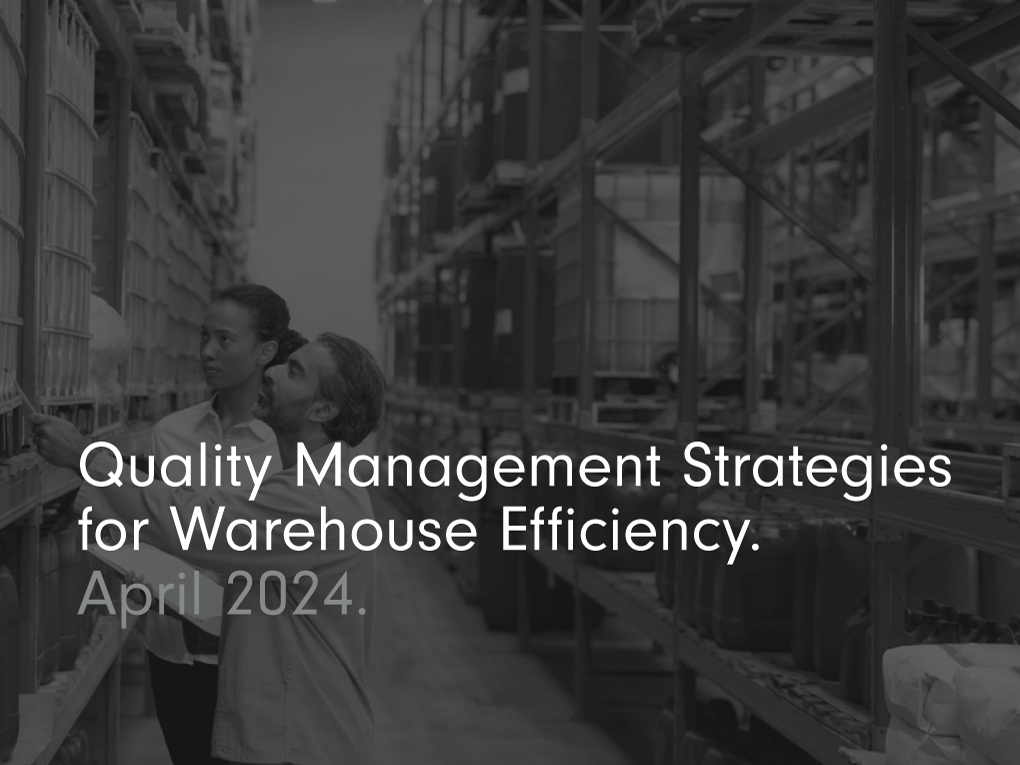10 Quality Management Strategies: Transforming Warehouse Efficiency.

In the high-stakes logistics and supply chain world, warehouse operations are the pivot point of success or downfall. In fast-paced environments, quality management is more than just checking boxes. It is a complex process resulting in increased productivity, satisfied customers, and improved profits. Here are 10 effective quality management strategies that warehouse professionals should consider to enhance efficiency and cut through the competition.
1. Implement Lean Principles.

Lean principles, inspired by the renowned Toyota Production System, focus on removing waste while improving the flow of operations. In the warehouse setting, this translates into less waiting, less movement, and fewer errors. Common lean strategies include the 5s (Sort, Set in Order, Shine, Standardise, Sustain), Value Stream Mapping, and Just-In-Time inventory management.
How to Begin Implementing Lean:
- Start with a full warehouse analysis to identify wasteful areas in the logistics process.
- Involve all staff in regular “Kaizen” events to continuously improve processes.
- Set up Kanban systems to replenish stock as it’s consumed, reducing excess inventory.
2. Invest in Advanced Warehouse Management Systems (WMS).

An effective WMS is the backbone of a well-managed warehouse. By automating inventory control, order fulfilment, and labour management, a robust WMS can significantly reduce human error and align picking, packing, and shipping activities.
Choosing the Right WMS:
- Consider scalability and flexibility to adapt to business growth and industry changes.
- Look for systems that integrate with other supply chain software and hardware, such as barcoding and RFID.
- Prioritise systems with user-friendly interfaces to enhance staff adoption and engagement.
3. Focus on Continuous Training and Development.

An empowered workforce is a productive one. Regular training sessions ensure that employees understand their roles and the processes involved. This also fosters a culture of continuous improvement. A WMS with built-in training modules or the ability to integrate with third-party learning management systems can help streamline this process and keep employees up-to-date on new procedures and technologies.
Guidelines for Effective Training:
- Offer cross-training opportunities to develop versatile teams.
- Use a variety of training methods to cater to different learning styles.
- Encourage employee feedback and suggestions for process enhancement.
4. Standardise Work Processes.

Standardising work processes lays the foundation for efficiency and quality. When employees across shifts and roles follow consistent procedures, warehouse managers can easily identify and resolve deviations. This results in improved accuracy, productivity, and overall performance. Additionally, standardising processes can help reduce errors and increase customer satisfaction.
By implementing effective training and standardising work processes, warehouse managers can see significant improvements in their operations. These measures not only improve efficiency but also contribute towards employee satisfaction and retention. With a well-trained and efficient team following standardised processes, warehouses can meet customer demands more effectively.
Steps to Standardisation:
- Create and document Standard Operating Procedures (SPOs) for every role and process in the warehouse.
- Update and review SOPs regularly to reflect best practices and changes in the industry.
- Engage employees throughout the standardisation process to ensure workability and acceptance.
5. Implement a Quality Control System.

A robust quality control system is essential for ensuring that products meet customer expectations. By catching defects early, you save time and money that would be wasted on reworks or returns. Quality control should be incorporated into every step of the warehouse process, including receiving, put-away, picking, and shipping. This can be achieved through regular inspections, testing, and audits.
To implement a quality control system, identify key quality checkpoints throughout your processes. These checkpoints should align with industry standards and customer expectations. Next, develop clear criteria for pass/fail results at each checkpoint. This will ensure consistency and accuracy in your quality checks.
Once you have established your checkpoints and criteria, train your team to conduct quality control inspections. This includes proper techniques for inspection, documentation of results, and reporting any issues or defects found.
It’s important to regularly review and update your quality control system as new products or processes are introduced.
Quality Control Best Practices:
- Run regular quality checks on inbound and outbound goods.
- Implement a system of checks and balances, such as a ‘two-person’ rule for high-value items.
- Use data from quality inspections to identify recurring issues and take corrective action.
- Invest in a WMS which has automated QC workflows and processes.
6. Optimise Inventory Management.

Effective inventory management is crucial for avoiding stockouts, overstock, and other issues that can hamper efficiency. Orders can be fulfilled faster by maintaining optimal stock levels while minimising carrying costs.
To achieve this, have a system in place for tracking inventory levels and forecasting demand. This can be done through automated systems that use real-time data to make accurate predictions. Additionally, regularly review and adjust your safety stock levels to ensure you are prepared for unexpected spikes in demand.
Another key aspect of inventory management is the proper storage and organisation of goods. This includes implementing a first-in-first-out (FIFO) system for perishable items and properly labelling and categorising products to easily locate them when needed.
By optimising your inventory management practices, you can streamline operations, reduce costs, and improve overall efficiency.
Inventory Optimisation Techniques:
- ABC analysis to categorise inventory based on value and importance.
- Use historical data and demand forecasts to set par levels and reorder points.
- Regularly audit inventory to ensure accuracy and identify obsolete or slow-moving items.
7. Prioritise Safety and Workplace Organisation.

A safe environment is a productive environment. Workplace accidents not only disrupt operations but also lead to loss of morale and productivity. You can prevent accidents and promote a more efficient workflow by prioritising safety and maintaining a clean and organised workspace.
Safety and Organisation Tips:
- Conduct regular safety audits and address any potential hazards immediately.
- Set up designated areas for different tasks and equipment to reduce clutter and confusion.
- Provide training on proper lifting, handling, and storage procedures for items in the warehouse.
8. Leverage Technology for Decision Support.

Data-driven decisions are the key to staying ahead in the modern warehouse game. Technology such as machine learning, AI, and big data analytics can provide valuable insights for optimizing processes and predicting demands. By utilizing these tools, warehouse managers can make informed decisions that lead to increased efficiency and cost savings. Some examples of technology that can aid in decision-making include:
- Inventory management systems: These software solutions help track stock levels, monitor inventory movement, and identify potential issues such as overstocking or stock shortages.
- Warehouse automation: This involves using robots, conveyor systems, and other advanced technologies to streamline processes and reduce manual labour.
- Real-time monitoring: With the help of sensors and IoT devices, warehouse managers can monitor environmental conditions such as temperature and humidity in real time. This information allows for quick adjustments to be made to preserve product quality.
- Data analysis: By collecting data from various sources within the warehouse, managers can gain insights into key performance indicators (KPIs), such as inventory turnover and order fill rates. This information can be used to improve efficiency and make informed decisions.
Innovative Decision Support Systems:
- Use predictive analytics to anticipate order patterns and staffing needs.
- Explore autonomous vehicles and drones for safer and more efficient order picking.
- Build a centralised dashboard that provides real-time visibility into warehouse operations.
9. Foster a Culture of Accountability and Ownership.

When employees take ownership of their work and its outcomes, they are more likely to ensure that quality standards are met. Encouraging accountability at all levels can lead to a proactive and engaged team. This can be achieved through regular performance evaluations, recognition programs for high-performing employees, and open communication channels for feedback and suggestions.
Cultivating Accountability:
- Communicate individual and team goals related to quality and productivity.
- Recognize and reward employees who go above and beyond to maintain standards.
- Provide autonomy along with responsibility to promote a sense of ownership.
10. Plan for Scalability and Flexibility.

A quality management strategy should not only focus on the present but also on the future. Planning for scalability and flexibility ensures that your operations can pivot in response to changes in the market or business growth.
Strategies for Scalability and Flexibility:
- Design warehouse layout with future growth and technology integration in mind.
- Cross-train employees to handle a wider variety of tasks as the business evolves.
- Review and optimise processes regularly to keep up with changing demands.
Conclusion.

By using these methods and giving our best effort, we can transform warehouses into models of efficiency and quality. This transformation involves combining different strategies and approaches. It requires a dedication to doing our best in every aspect of warehouse management. Ultimately, this will elevate warehouses from being mere components of the supply chain to being shining examples of efficiency and quality.
It might appear overwhelming, but even adopting a few of these strategies can significantly enhance your warehouse management.
In conclusion, to make a warehouse more efficient and well-managed, you need a detailed plan. This plan should include using technology, following standard procedures, providing continuous training, and prioritising safety and responsibility.